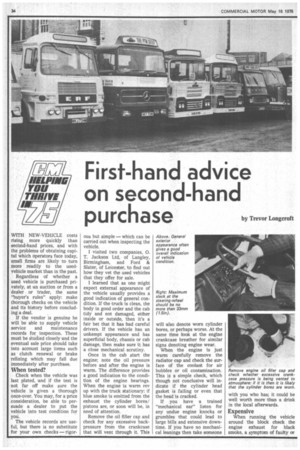First-hand advice on second-hand
Page 36

If you've noticed an error in this article please click here to report it so we can fix it.
purchase by Trevor Long croft WITH NEW-VEHICLE costs rising more quickly than second-hand prices, and With the problems of obtaining capital which operators fate today, small firms are likely to turn more readily to the usedvehicle market than in the past.
Regardless of whether a used vehicle is purchased privately, at an auction or from a dealer or trader, the same "buyer's rules" apply: make thorough checks on the vehicle and its history before concluding a deal.
If the vendor is genuine he will be able to supply vehicle service and maintenance records for inspection. These must be studied closely and the eventual sale peice should take into account large items such as clutch renewal or brake relining which may fall due immediately after purchase.
When tested?
Check when the vehicle was last plated, and if the test is not far off make sure the vehicle is given a thorough once-over. You may, for a price consideration, be able to persuade a dealer to put the vehicle into test condition for you.
The vehicle records are useful, but there is no substitute for your own checks — rigor ous but simple — which can be carried out when inspecting the vehicle.
I visited two companies, 0. T. Jackson Ltd, •of Langley, Birmingham, and Ford & Slater, of Leicester, to find out how they vet the used vehicles that they offer for sale.
I learned that as one might expect external appearance of the vehicle usually provides a good indication of general condition. If the truck is clean, the body in good order and the cab • tidy and not damaged, either inside or outside, 'then it's a fair bet that it has had careful drivers. If the vehicle has an unkempt appearance and has superficial body, chassis or cab damage, then make sure it has a close mechanical scrutiny.
Once in the cab start the engine; note the oil pressure before and after the engine is warm. The difference provides a good indication to the condition of the engine bearings. When the engine is warm rev up with the truck stationary: if blue smoke is emitted from the exhaust the cylinder bores/ pistons are, or soon will be, in need of attention.
Remove the ail filler cap and check for any excessive backpressure from the crankcase that will vent through it. This will also denote worn cylinder bores, or perhaps worse. At the same time look at the engine crankcase breather for similar signs denoting engine wear.
When the engine is just warm carefully remove the radiator cap and check the surface of the coolant for air bubbles or oil contamination. This is a simple check, which though not conclusive will indicate if the cylinder head gasket is failing or even that the head is cracked.
If you have a trained "mechanical ear" listen for any undue engine knocks or grumbles that could lead to large bills and extensive downtime. If you have no mechanical leanings then take someone with you who has; it could be well worth more than a drink in the local afterwards.
Expensive
When running the vehicle around the block check the engine exhaust for black smoke, it symptom of faulty or




























































































